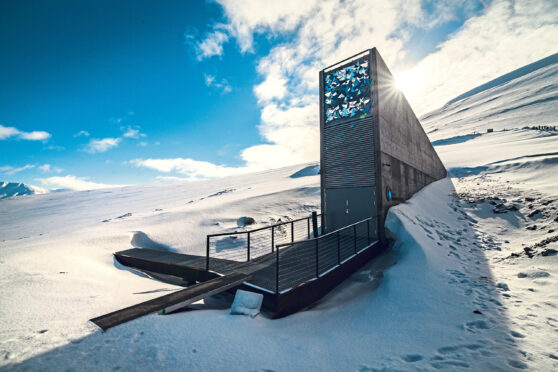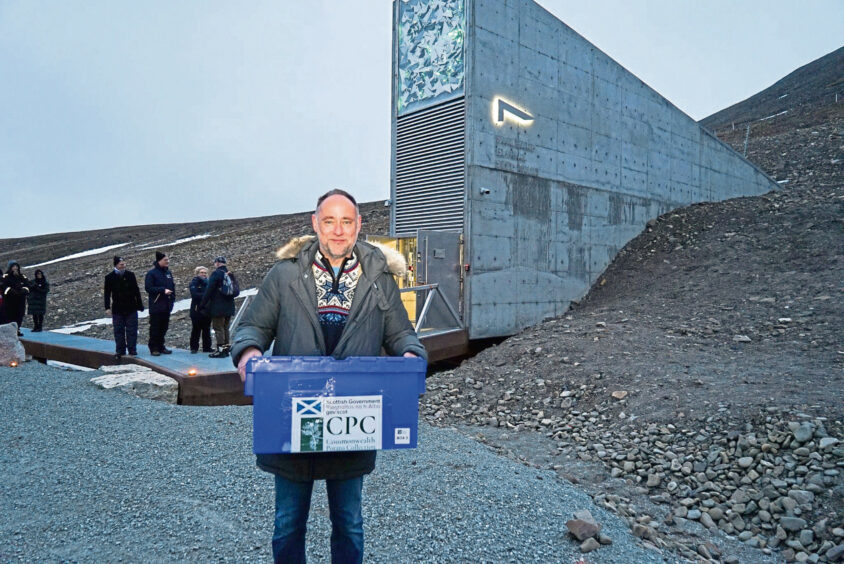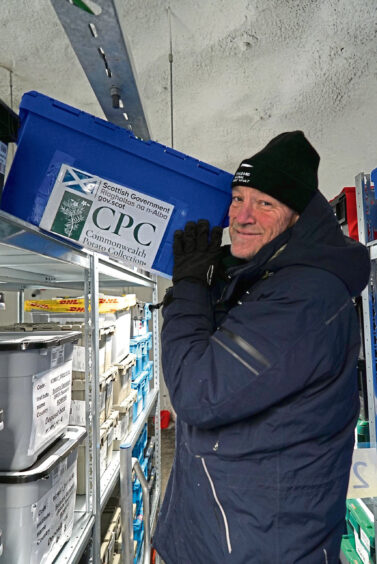Nestled into the hillside in the stunningly desolate Svalbard region of Norway, the entrance to the global seed bank looks like part of the set of an epic disaster movie.
Picture a dishevelled Liam Neeson rolling in under a rapidly-closing door as the surrounding area is destroyed by a volcano/meteor/huge storm and you’ve got the idea.
In fact, this futuristic structure could indeed hold the secret to the survival of humanity: Not by giving refuge to people but rather by storing seed samples from the world’s most important crop collections.
The Svalbard Global Seed Vault is a safe storage facility of more than one million seed samples and is the world’s largest collection of crop diversity. The seeds are stored here as a kind of insurance policy against an event or events that could destroy our food crops.
The James Hutton Institute in Dundee has been contributing seeds to the collection for several years, with the most recent deposit of Scottish seeds taking place earlier this month.
Gaynor McKenzie, 43, is the curator of the UK’s only potato gene bank, The Commonwealth Potato Collection, based at Dundee’s James Hutton Institute.
“Managing a gene bank, such as the Commonwealth Potato Collection (CPC), requires maintaining both the genetic integrity and physical viability of the seed under your care,” she explains.
“To achieve this, we follow the voluntary standards detailed in The Gene Bank Standards for Plant Genetic Resources for Food and Agriculture. These standards set the benchmark for current gene bank best practices and encourage the creation of a safety duplicate for each original sample to be held in a geographically distant location.”
The distant location is where Svalbard comes in, and Gaynor has been lucky enough to visit the Svalbard facility in person: “In February 2017 I had the once-in-a-lifetime opportunity to visit the seed vault at Svalbard and make the first seed deposit for the James Hutton Institute and the UK,” she enthuses.
A privileged few
“Visitors are no longer permitted to enter the vault, so I feel very privileged to have been one of the few people to have been afforded this opportunity. From the impressive bespoke artistic design of the entrance-way to the large temperature-controlled chambers housed deep within the mountainside, the vault itself is a breath-taking spectacle of practical design.”
Gaynor says the vault, which has been built into a mountain on the remote island of Spitsbergen, 1,300km inside the Arctic Circle, “safeguards duplicate seed samples from the world’s crop collections and currently contains over 1 million different seed samples with the capacity for many more. The storage facility is designed to stand the test of time and provide the ultimate insurance policy to protect invaluable genetic resources from possible future catastrophic global environmental events.”
Into the mountainside
She recalls the experience of visiting the facility in 2017: “After walking down a long corridor that takes you 100m within the mountain, and under layers of rock that range between 40 and 60 metres thick, you discover hidden chambers containing multitudes of boxes from almost every country in the world. The ultimate library of genetic resources!
“On these shelves now safely sits a duplicate of the Commonwealth Potato Collection, ensuring its long-term viability.”
The only seeds from Scotland to be housed in the vault have come from the James Hutton Institute, which is one of three UK depositors. Other contributions come from all over the globe with Iraq and Uruguay the most recent nations to make their first seed deposits. Gaynor explains the relationship with the James Hutton Institute began when she attended a talk given by Åsmund Asdal, the Svalbard Global Seed Vault coordinator.
“This talk highlighted the importance of the Seed Vault and encouraged gene bank curators to think about depositing material into the vault,” she says.
“The talk, along with my desire to create a new collection back-up, resulted in our initial seed deposit at Svalbard in February 2017.”
Not so humble after all?
According to the curator of the Commonwealth Potato Collection, Solanum tuberosum (or the humble spud) is a vital food crop. “The accessions we are depositing consist of both primitive cultivated and crop wild relatives, which are wild plant species genetically related to cultivated crops.
“Untended by humans, they continue to evolve in the wild, developing traits such as drought tolerance or pest resistance. We crossbreed these with domesticated crops to produce new varieties within our collection including the original ancestors of today’s cultivated potatoes.”
Gaynor points out that because these wild potatoes cover a wide geographical range, they are very adaptable, allowing them to “occupy an impressive range of habitats varying in temperature, humidity and altitude.
“The Commonwealth collection contains species supremely able to thrive in diverse and challenging environmental conditions. For example, some can survive in high altitudes paired with bouts of sub-zero temperatures or dry semi-desert conditions; some thrive in humid conditions of Bolivian cloud forests; or are covered in soft sticky hairs that produce a pungent insect-repelling odour.
“The collection even contains a species that is somewhere between a potato and tomato!”
The most recent deposit of seeds, made on October 12, contained 383 accessions.
Gaynor believes that: “In a world dealing with the effects of climate change, it has never been so important to preserve this valuable material.”
Vital insurance policy
John Jones, nematologist and science group leader at The James Hutton Institute, agrees: “The seed bank offers an insurance policy against any catastrophic events that would threaten a collection held only in one place,” he explains, “but also against climate change, by housing genetic diversity from crops that occupy a wide range of habitats.
“Understanding the genetic basis of the ability to grow in these conditions is essential if we are to be able to breed new varieties of potato that can cope with the elevated temperatures we are likely to see in future.”
According to John, experts are already seeing examples of the impact of climate change on crops. “Some natural resistance genes stop working at temperatures over 28C, meaning the plants are no longer protected from pathogen attack,” he says. Even more alarming is the news that: “Growers in Southern Europe are already seeing the impact of this breakdown of resistance.
“Some of the recent modelling work undertaken by colleagues at Hutton has shown that farms in the south of England will experience up to two months of conditions every year where plants are exposed to temperatures that will induce heat stress. This will impact the way that the plants grow and the amount of food we produce.”
New varieties
Sending potato seeds to Svalbard is just one aspect of the work John, Gaynor and their colleagues are undertaking in order to ensure the global food supply in the future.
“We are breeding new crop varieties that are able to cope with a changing climate and that can thrive with lower levels of fertiliser,” says John. “We are also using our expertise to help growers in other parts of the world who are dealing with pathogens that have not previously been a problem in their countries.”
Åsmund Asdal reiterates the importance of plant genetic resources for future food security. “It is crucial that genebanks provide genetic material to agricultural research and plant breeding,” he points out.
“One of the 93 contributors is the James Hutton Institute, which conserves a unique collection of potato diversity. We are happy to see that genetic diversity of this globally important food crop is secured in the Seed Vault, and look forward to future cooperation with the James Hutton Institute.”
When it comes to ensuring we will be able to continue to successfully grow food crops whatever climate change or other global events throw at us, the Global Seed Vault could well be a lynchpin.
It’s incredible to think a safe storage unit in the far reaches of the Arctic Circle may well hold the seeds of crops that could ensure our very survival.
To find out more about the James Hutton Institute’s contribution visit the Commonwealth Seed Collection website or see more on the Global Seed Vault here.




